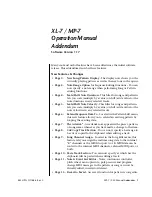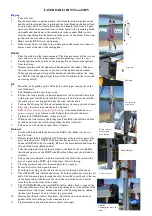
18
Safety Information
Check the Pressure While Not Blasting
The pressure should drop below 500 psi (34 bars)
after the STOP switch is pressed. If it stays higher
you must check the Dump Valve Shut-Off Cartridge.
Do not use the equipment until the repair is made.
Know Your Surroundings
Know your surroundings well – i.e. truck, hoses,
people, walls, moving vehicles, traffic, live traffic
lanes, etc.
Never Blast While Stopped
Always make sure to stop blasting before stopping
the truck. Blasting while the machine is stopped
will damage the road surface.
1.3 Nozzle Safety
Check Flow Rating
Know the flow rate of the UHP Pump. Because the
UHP Pump is a positive displacement pump it de-
velops a specific pressure at a specific flow rate.
A combination of nozzles must be used that does
not exceed the flow rate for a given pressure. Use
the above chart to calculate the flow rate of a given
combination of nozzles and make adjustments as
necessary to achieve the pressure you desire. Worn
out or “Blown” nozzles use more water and reduce
the possibility of achieving your desired pressure.
Check Pressure Rating
Use only nozzles with a manufacturer’s minimum
burst rating of 60,000 psi.
Check Nozzle Stream
After installing new nozzles and before installing the
Spray Bar Protectors you must check the nozzles
at operating pressure to make sure there are no
leaks and the streams are “Needle Sharp”. Refer
to the Nozzle Cohesivity Chart to decide if the new
nozzles should be replaced or not. It is common
to replace 10% of new nozzles due to undesired
nozzle streams.
Use Anti-seize
Use plenty of Anti-seize on each nozzle and make
sure they go into the Spray Bar easily. Never force
the nozzle into the socket as it will permanently
damage the threads. Never use power tools to
run the nozzles in or out. Always turn the nozzles
by finger as much as possible. If the threads gall
you should use a back and forth motion to slowly
extract it from the Spray Bar. Never use more than
20 ft lbs of torque.
Installing Nozzles
Insert the nozzle into the Spray Bar finger tight.
Using a 3/8” socket tighten the nozzle about 15%
more. Do not over-tighten. If the nozzle won’t seal
this way the seat may be damaged and must be
reconditioned.
Clogged Nozzles
The orifices of the nozzles are so small that they
can be clogged by particles too small for the hu-
man eye to see. You must take great precaution
to keep the nozzles clean or they will be clogged
immediately upon starting the machine. Clogged
nozzles should be discarded and replaced. Trying
to unclog the orifice usually results in damaging
or dislodging the sapphire and destroying the
nozzle. Clean, careful habits will save lots of time
and prevent clogged nozzles.
Remove a Nozzle from Service if:
A. Nozzle is split or damaged
B. Nozzle is clogged
C. Nozzle Stream is fanned
D. Nozzle cannot hold pressure or is suspected
to be weak
E. Nozzle Hex Head is rounded off
F. Nozzle Threads are damaged
1.4 Hose Safety
Check Pressure Rating
Use only hoses with a Minimum Burst Rating of
60,000 psi (4,136 bars)
Minimum Radius
Never bend the hose tighter than the minimum ra-
dius as given by the manufacturer. Smaller hoses
can be bent tighter than larger ones. If the mini-
mum radius is exceeded the hose will fail quickly
at that point. You should discard any hose that
has exceeded the minimum radius. When an Ultra
High Pressure Hose ruptures it can be extremely
dangerous to personnel in close proximity.
Leaking Fittings
Never tighten leaking hose fittings while they are
under pressure. There is a risk of injection injury.
Turn off the Pump then tighten the fittings before
continuing. Leaks in hose connections can destroy
the hose within minutes.
Summary of Contents for Stripe Hog SH5000
Page 1: ...Operations Manual...
Page 2: ...2...
Page 4: ...4 THIS PAGE WAS LEFT BLANK INTENTIONALLY...
Page 6: ...6 THIS PAGE WAS LEFT BLANK INTENTIONALLY...
Page 8: ...8 THIS PAGE WAS LEFT BLANK INTENTIONALLY...
Page 14: ...14 THIS PAGE WAS LEFT BLANK INTENTIONALLY...
Page 20: ...20 THIS PAGE WAS LEFT BLANK INTENTIONALLY...
Page 50: ...50 THIS PAGE WAS LEFT BLANK INTENTIONALLY...
Page 58: ...58 THIS PAGE WAS LEFT BLANK INTENTIONALLY...
Page 92: ...92 Component Repair THIS PAGE WAS LEFT BLANK INTENTIONALLY...
Page 94: ...94 Component Repair...
Page 96: ...96 Component Repair...
Page 98: ...98 Component Repair...
Page 99: ...99 Fluid End Replacement Parts Appendix A Drawings and Supplies...
Page 100: ...100 THIS PAGE WAS LEFT BLANK INTENTIONALLY...
Page 104: ...104 THIS PAGE WAS LEFT BLANK INTENTIONALLY...
Page 106: ...106 THIS PAGE WAS LEFT BLANK INTENTIONALLY...
Page 110: ...110 THIS PAGE WAS LEFT BLANK INTENTIONALLY...
Page 118: ...118 THIS PAGE WAS LEFT BLANK INTENTIONALLY...
Page 121: ......
















































